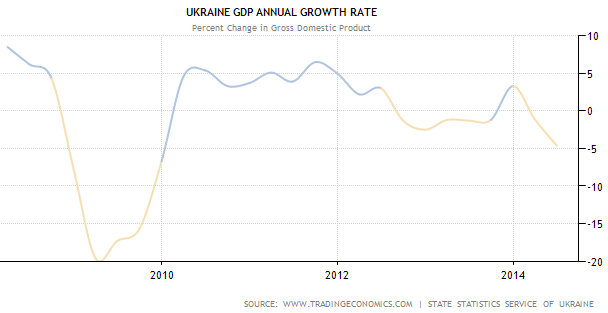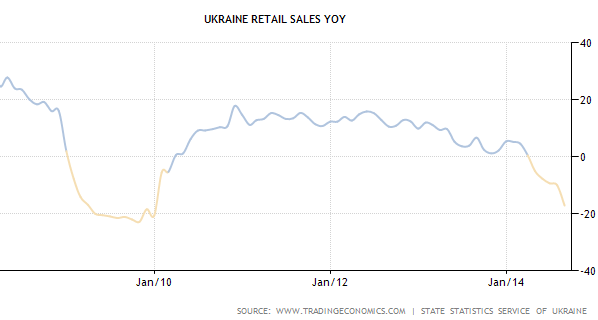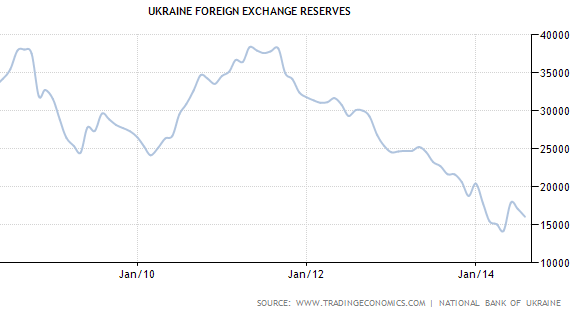While we see a great deal of media coverage of Ukraine-related geopolitical risks, there hasn't been sufficient discussion about the dire economic and fiscal conditions the nation is facing. Writing about men in masks fighting in eastern Ukraine sells far more advertising than covering the nation's economic activity. However it's the economy, not the Russian army that has brought Ukraine close to the brink. And just to be clear, some of Kiev's economic and fiscal problems were visible long before the spat with Russia (see post from 2012).
Ukraine is now in recession. Deep economic ties with Russia have resulted in painful adjustments in recent months. The nation's exports are down some 19% from last year in dollar terms and expected to fall further. A great example of Ukraine's export challenges is the Antonov aircraft company known for its Soviet era large transport planes as well as other types of aircraft.
As military cooperation with Russia ended, Antonov was in trouble. It had to take a 0 million hit recently by not delivering the medium-range An-148 planes to the Russian Air Force. The Russians will find a replacement for this aircraft, but in the highly competitive global aircraft market, it's far less likely that Antonov will find another client.
Here are some key indicators of Ukraine's worsening situation:
1. The nation's GDP is down almost 5% from a year ago and growth is expected to worsen.
2. Ukraine's retail sales are falling at a rate we haven't seen since the financial crisis.
3. And industrial production is collapsing.
4. The most immediate concern however is the nation's currency, which has been trading near record lows in spite of currency controls. In fact, Friday's fall in hryvnia was unprecedented (over 11%), as Kiev fails to stem capital outflows.
Intraday exchange rate (source: Bloomberg)
Those who have spent any time in Ukraine during the winter know how harsh the weather can get. And at these valuations, hryvnia isn't going to buy much heating fuel from abroad. Furthermore, it's not clear if the government will have the wherewithal to provide sufficient assistance to the population.
5. Inflation rate is running above 14% and will spike sharply from here in the next few months if the currency weakness persists. Real wages are collapsing.
6. Finally, Ukraine's fiscal situation is unraveling. In its attempts to defend the currency, Kiev has been using up its foreign exchange reserves. It is only the access to some IMF funding that has allowed Ukraine's government to maintain some semblance of order in its FX markets.
Moreover, public debt levels continue to rise as the government attempts to keep the Ukrainian banking system afloat.
Fitch Ratings: - Government debt (including guarantees such as NBU liabilities to the IMF) to GDP has quadrupled since 2008, reflecting exchange rate depreciation, fiscal deficits, low growth and below-the-line costs such as recapitalisation of banks and Naftogaz. There is high dollarisation and foreign-currency exposure, making government solvency, banks' balance sheets and the overall economy vulnerable to sharp depreciation.
A number of economists now believe that given the worsening economic crisis, the country's public debt problem is simply unsustainable and default is becoming increasingly likely.
Goldman: - We continue to see downside risks to activity and to our forecast for a contraction of output of 8% this year and for growth of 1% next year. As we recently argued, this severe economic weakness is likely to cause public debt to rise to 70% this year and 77% next year, above the IMF’s “high-risk threshold” for debt sustainability. These downside risks to our forecasts further call into question the sustainability of Ukraine’s debt trajectory.












